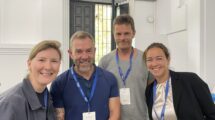On 13 June 2021 we celebrate the 35th anniversary since the establishment of RARE (later TERENA and then merged with DANTE to form the GÉANT Association) and the start of formal collaboration among European NRENs. On the occasion, we interviewed Dutch internet pioneer Kees Neggers, who was at the heart of the initiative since its beginning.
Kees, you played a key role in the birth of European Research and Education Networking. How did it all start?
In the early 80’s, there was a growing need for international networking and the research communities of several disciplines already started their own network (HEPnet for the high-energy physics, SPAN for astronomy, etc.).
The first international network in Europe was EUnet[1], which was founded in 1982 and connected Unix computers. Then in 1984 IBM started to sponsor a project called EARN (European Academic and Research Network). That was my first international networking experience. Back then I worked at University of Nijmegen, which became the EARN node in the Netherlands and I was appointed Netherlands’ member of the EARN Board of Directors.
To build the EARN network, IBM managed to convince national PTT (Postal, Telegraph, and Telephone service) authorities in Europe that researchers needed leased lines, rather than the dial-up lines in use, with the promise to give lines back within three years and upgrade to X.25.
Very rapidly EARN became a big success: it was proven technology, it worked instantly, and people could not do without it anymore. At the same time, no one in Europe wanted to rely on IBM or IBM protocols for either national or international networking. A different solution was needed, and governments and PTTs were quite keen to support activities towards an open infrastructure.
How did RARE originate and what was its purpose? What was your role in it throughout its history?
You could say RARE (Réseaux Associés pour la Recherche Européenne) started as a reaction to EARN, which was IBM-dominated. Additionally, computers were already connecting to each other, both nationally and internationally, but only the same-model computers could talk with each other.
We wanted to have an environment where everybody could speak to everybody via open standards. Even the big companies and PTTs supported it, because they realised that – in the end – they had to provide connectivity to all. The idea initially took shape in May 1985 at an informal workshop in Luxembourg.
At the time, in the Netherlands we were lagging behind. Particularly Germany, UK and the Nordics already had well established networking organisations. We wanted to step in and established the SURF project to provide plans for national networking.
To kick-start more international cooperation, I then received 100,000 ECU [*European Currency Unit, predecessor of Euro], from the SURF-project, soon matched by the European Commission. Within a year and thanks to those funds RARE was officially established, on 13 June 1986.
I was in the RARE executive for most of the first 15 years, then for the next 10 years still represented SURFnet in the General Assembly, and finally – after my retirement at SURFnet in 2012 – I became more of an interested observer.
RARE was also decisive in the “Protocol Wars” between OSI and IP standards. How did we end up with the current IP-based network?
The European governments strongly supported OSI over IP and – through the Eureka[2] organisation – had asked RARE in 1986 to start the COSINE project to define and design an OSI-based network, and then to start its implementation.
As part of COSINE, RARE had started a joint working group with EUnet, EARN and HEPnet to define a better transport infrastructure. This led to an agreement between the Commission and PTTs to deliver the International X.25 Interconnect (IXI), a pan-European private X.25 network based on 64Kbps leased lines to support the research community in Europe. Unfortunately, even before its start, we ran into infrastructural limits: we definitely needed more and different capacity! In May 1990 RARE, while still executing the COSINE Implementation Phase, expressed the need for support of a multiprotocol backbone service and NORDUnet had already decided to implement one.
Meanwhile, at SURFnet, together with the national PTT, we had started a 2Mbps multiprotocol pilot in 1991, which demonstrated that X.25 could not support more than 360 Kbps and showed that embedded X.25 was no longer a solution. As a result, we introduced a 2Mbps multiprotocol network in the Netherlands and initiated and sponsored a task force to plan for a European multiprotocol backbone. This resulted in Ebone, the first pan-European IP backbone which became operational in 1992. RARE provided administrative support and became the Ebone clearing house.
Although PTTs and governments formally only supported OSI initiatives, they understood the need and did not forbid Ebone, which we had presented as an interim multi-protocol activity that also included a pilot connectionless OSI service. Ebone was a major success and within a year COSINE and the Commission formally approved the next generation of European backbones to be multi-protocol.
Finally, in 1992 the predominance of IP led RARE to host the Réseaux IP Européens Network Coordination Centre (RIPE NCC), which later became a separate entity.
What would you say were RARE’s main achievements?
RARE made the difference by being pragmatic, by listening to the users and involving them, by discovering and predicting their needs and matching them with our knowledge about technical possibilities. This was demonstrated again in 2001 by TERENA’s support of GLIF, the Global Lambda Integrated Facility, when the Internet alone was no longer capable to support all the researchers needs.
Clearly the main achievements of RARE, then TERENA, and following the merger with DANTE now the GÉANT Association, are that they built and supported a community, established a close liaison with users, and that they were always open to users’ input and to following up on users’ initiatives.
A nice example of that is eduroam. At SURFnet, when Klaas Wierenga came to me and proposed the idea we immediately recognised that international scale was essential to make it a success, so I suggested him to first get support from TERENA. He did and today the whole world is using it!
Ebone, RIPE NCC, GLIF and eduroam were all bottom-up activities. This spirit was essential for RARE and for TERENA and it should remain the main spirit of GÉANT.
In 1994 RARE finally merged with EARN to form TERENA. What led to that decision?
In 1993 RARE had established DANTE as a professional organisation to secure the provisioning of pan-European services, so far provided by its CPMU (COSINE Project Management Unit), after the end of the COSINE implementation phase.
IP becoming dominant, EARN services were no longer needed and it became obvious that DANTE would take the role as pan-European NREN service provider. EARN and RARE so far had played several important and complementary roles, but it was useless to have them continuing as separate entities more or less providing the same services to the same community.
I was a linking pin between the two worlds, as the only person present from the beginning in both the RARE Board and the EARN General Assembly. This was helpful but also quite difficult, especially due to tensions during the Protocol Wars. Sometimes there were hostile environments, which were completely unneeded and unnecessary, as we had the same ultimate goals! The challenge was to find the cooperation and collaboration to do what was needed.
What were the main challenges and obstacles you encountered and how did you overcome them?
In the beginning there was a lack of infrastructure and a lack of support from PTTs and industry, all with their own private protocols. Then, due to the mismatch in needs and possibilities, it was very challenging to find consensus on what was possible internationally.
Furthermore, there were too many discrepancies in the different governance structures. The TERENA General Assembly, the NREN PC (Project Committee for EC sponsored projects) and the DANTE Shareholders were – all in parallel – trying to control the European scene.
At my last TERENA assembly meeting in Reykjavik in 2012, a group was formed to solve these governance problems. Ultimately, the proposals from the Reykjavik Group led to the merger of TERENA and DANTE to create the GÉANT Association, in October 2014.
To summarise, the main challenges and obstacles were both external (Government policies and the monopoly of PTTs) and internal (the governance structures). My impression is that currently they are overcome, so in principle GÉANT’s future now looks bright.
To conclude, how do you imagine the future of research and education networks?
Throughout the years, our organisations and NRENs were able to address the demand of our community, by developing services that were not yet available on the market. To do that, you need to be agile, adapt to the changing circumstances and grab opportunities. GÉANT needs to keep service provision at the front of what is possible, because that’s what researchers will always need.
For the future I suggest keeping a close connection with the user base, looking for opportunities, understanding that what you provide today is not the ultimate solution and consistently reviewing the current system to improve it.
Finally, we have to be aware that the internet we have today has severe limits, as it was an interim solution from the start. The problems at its core need to be solved and the GÉANT community, which successfully introduced the current internet in Europe, should now take responsibility for providing its community with a better network, suited for the next 35 years.
[1] EUnet provided communication between Unix systems on an operating system specific basis.
[2] Intergovernmental organisation for research and development funding and coordination http://www.eurekanetwork.org/
This article is featured on CONNECT37! Read or download the full magazine here







